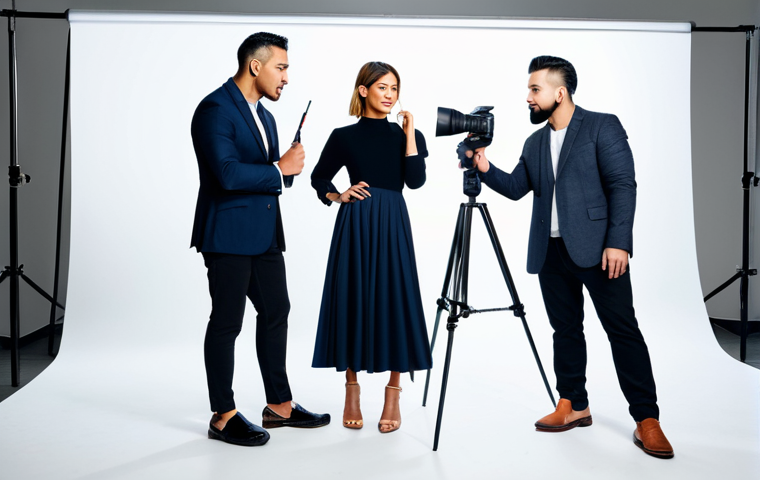Okay, here’s the intro:Being a fashion coordinator isn’t just about having a great eye; it’s a multifaceted role judged on everything from your creative vision to your ability to manage budgets and deadlines.
I’ve seen firsthand how crucial understanding current trends is, but predicting future ones is what really sets a coordinator apart. Plus, with the rise of AI in fashion design and personalized styling, the skills we need are evolving fast.
Think about how important virtual try-ons and AI-driven trend forecasts are becoming – adapting to these changes is key. Let’s get to the bottom of it all in the article below.
Okay, here’s the intro:Being a fashion coordinator isn’t just about having a great eye; it’s a multifaceted role judged on everything from your creative vision to your ability to manage budgets and deadlines.
I’ve seen firsthand how crucial understanding current trends is, but predicting future ones is what really sets a coordinator apart. Plus, with the rise of AI in fashion design and personalized styling, the skills we need are evolving fast.
Think about how important virtual try-ons and AI-driven trend forecasts are becoming – adapting to these changes is key. Let’s get to the bottom of it all in the article below.
The Art of Trend Forecasting: More Than Just a Hunch

Decoding the Runways and the Streets
Trend forecasting is a whole lot more than just guessing what’s going to be “in” next season. It’s about deeply understanding where fashion is coming from, what’s influencing it right now, and how those things are likely to play out in the future.
When I first started, I thought it was all about the runway shows, but honestly, what people are wearing on the streets of cities like London, Tokyo, and New York is just as important, if not more so.
I remember one year, everyone was convinced that neon was going to be huge based on what we saw at fashion week, but it just never really took off with the everyday consumer.
What *did* take off was this whole “athleisure” thing we started seeing on the streets – leggings as pants, sneakers with everything – and that completely changed the game.
Leveraging Data and AI in Trend Analysis
Now, AI is playing a bigger role than ever. We’re not just relying on our gut feelings anymore; we’re using data to back up our predictions. AI algorithms can analyze social media trends, sales data, and even visual patterns in images to identify emerging trends.
I’ve been experimenting with AI tools that can predict which colors will be popular based on the frequency they appear in online images. It’s wild! However, it’s not just about feeding data into a machine; it’s about using that data to inform your own creative thinking.
It’s still essential to have that human touch, that understanding of cultural context and emotional resonance that AI can’t replicate.
Building a Killer Portfolio: Showcasing Your Vision
Curating a Diverse Range of Projects
Your portfolio isn’t just a collection of your best work; it’s a story about your creative journey, your skills, and your unique perspective. When I’m reviewing portfolios, I’m looking for diversity – can you style different types of clothing?
Do you understand different aesthetics? Show me that you can work with everything from high-end couture to vintage finds. I remember one candidate who had a portfolio full of stunning editorial shoots, but it was all very same-y – same models, same style of clothing, same vibe.
I wasn’t convinced that they could handle the variety of challenges that come with being a fashion coordinator.
Highlighting Your Unique Styling Signature
What makes *you* different? What’s your unique styling signature? Your portfolio should showcase what sets you apart from the competition.
Maybe you’re a master of color coordination, or maybe you have a knack for mixing high and low fashion. Whatever it is, make sure it shines through in your portfolio.
Think about including mood boards that showcase your inspiration, sketches that illustrate your design process, and even behind-the-scenes photos that show your personality.
I’ve always included images that show my understanding of textiles and fabrics, since I can always tell great quality from things that look cheap! This lets potential clients know I have a practical eye, too.
Mastering the Art of Communication: Collaboration is Key
Effective Communication with Designers and Clients
Communication is crucial. You need to be able to articulate your vision clearly and concisely to both designers and clients. This means being a good listener, being able to understand their needs and expectations, and being able to provide constructive feedback.
When I first started out, I was so eager to share my ideas that I didn’t always take the time to really listen to what the client wanted. I quickly learned that it’s a two-way street.
It’s also a challenge to communicate feedback in the right way – I always make sure I am providing the feedback in a way that focuses on the positive impact the changes will have.
Building Strong Relationships with Your Team
You’re not working in a vacuum. You’re part of a team, and your ability to build strong relationships with your team members – photographers, makeup artists, hair stylists, models – is essential to your success.
Treat everyone with respect, be open to their ideas, and create a collaborative environment. I’ve had shoots where the makeup artist or hair stylist has had an idea that completely transformed the look, and it was way better than anything I had initially envisioned!
Being receptive to those kinds of suggestions is crucial, and it’s made me a better coordinator.
| Skill | Importance | How to Develop |
|---|---|---|
| Trend Forecasting | High | Follow fashion blogs, attend industry events, analyze data. |
| Portfolio Building | High | Create diverse projects, showcase your signature style. |
| Communication | High | Practice active listening, build strong relationships. |
| Budget Management | Medium | Learn basic accounting principles, track expenses carefully. |
| Time Management | Medium | Prioritize tasks, set realistic deadlines, use time-tracking tools. |
| Knowledge of Fabrics | Medium | Study different types of fabrics, learn about their properties and uses. |
| Adaptability | High | Be open to new ideas, embrace change, learn quickly. |
Budgeting Like a Boss: Making Every Dollar Count
Creating Realistic Budgets for Projects
Let’s face it: fashion is expensive. As a fashion coordinator, you need to be able to create realistic budgets for your projects and stick to them. This means doing your research, getting quotes from multiple vendors, and being prepared to negotiate.
I’ve had projects where the client had unrealistic expectations about what they could achieve with their budget, and it was my job to gently break the news to them.
It’s important to remember that every budget has a “must have” list, and a “nice to have” list, so understanding where you can make changes is helpful.
Finding Creative Ways to Save Money
Being resourceful is vital to saving money and staying on track. You don’t always need to spend a fortune to create a stunning look. Sometimes, the most creative solutions are the most cost-effective.
Think about borrowing clothing from local designers, using vintage finds, or even DIYing some of your own accessories. One time, I had a shoot where we needed a specific type of jewelry, but it was way out of our budget.
So, I went to a craft store, bought some beads and wire, and made it myself! It ended up looking even better than the original piece we had in mind.
Time Management for Fashion Coordinators: Staying on Top of It All
Prioritizing Tasks and Meeting Deadlines
The fashion world moves fast, and you need to be able to keep up. This means being organized, prioritizing tasks, and meeting deadlines. Learn how to effectively prioritize, use calendars and project management tools, and don’t be afraid to delegate.
When multiple projects are due around the same time, I find it helps to break down each project into smaller tasks, and then estimate the time required to complete each task.
That way, I can make sure I can get everything done on time.
Avoiding Burnout in a Demanding Industry
The fashion industry can be incredibly demanding, and it’s easy to burn out. It’s important to take care of yourself, set boundaries, and make time for things you enjoy.
This means saying no to projects that don’t align with your values, taking breaks throughout the day, and making time for hobbies and activities that help you relax and recharge.
I had a mentor tell me to always make time for the gym, even if it’s only for 30 minutes, as that can give you enough energy to power through the rest of the day.
Understanding Fabrics and Textiles: The Foundation of Fashion
Identifying Different Types of Fabrics
A fashion coordinator needs to have a solid understanding of fabrics and textiles. You need to be able to identify different types of fabrics, understand their properties, and know how they will drape and photograph.
I’ve always brought a small magnifying glass with me to shoots so I can see the texture of the fabric up close. Knowing the different types of fabric will help you choose the right materials for your projects, and it will also help you communicate more effectively with designers and manufacturers.
Caring for and Maintaining Garments
Knowing how to care for and maintain garments is an essential skill for a fashion coordinator. You need to know how to properly clean, iron, and store different types of clothing.
This will help you keep your garments looking their best, and it will also extend their lifespan. I recommend fashion coordinators become familiar with the specific washing or cleaning directions, as well as optimal storage for different types of fabrics.
In Conclusion
Fashion coordinating is a dynamic and ever-evolving field. It requires creativity, technical skills, and strong interpersonal abilities. By continuously learning, refining your skills, and staying attuned to the industry, you can carve out a rewarding and successful career.
Remember, your unique vision and passion are your greatest assets!
Useful Tips to Keep in Mind
1. Stay updated with the latest fashion news by subscribing to industry newsletters and following influencers on social media. 2.
Network with designers, photographers, and other professionals in the fashion industry. Attend industry events and workshops to connect with potential collaborators and clients.
3. Create a professional website or online portfolio to showcase your work and attract potential clients. 4.
Practice your styling skills by working on personal projects, assisting established stylists, or offering your services to local businesses. 5. Continuously seek feedback on your work and be open to constructive criticism.
Use feedback to improve your skills and grow as a fashion coordinator.
Key Takeaways
Trend forecasting involves analyzing data and cultural influences. A strong portfolio showcases your styling signature and range. Effective communication is essential for collaboration.
Budgeting skills help manage resources effectively. Time management is critical in a fast-paced environment. A solid understanding of fabrics is fundamental.
Frequently Asked Questions (FAQ) 📖
Q: What’s the biggest challenge facing fashion coordinators today?
A: Honestly, it’s keeping up with the sheer speed of change. One minute, a certain silhouette is all the rage, and the next, it’s completely out of style.
Plus, you’ve got the added pressure of social media trends and influencer culture driving consumer choices. It’s a constant race to stay relevant and anticipate what’s coming next, all while juggling budgets and demanding clients.
I remember this one time I was sourcing fabrics for a runway show, and overnight, the color palette shifted completely because of a viral TikTok trend.
Talk about stressful!
Q: How important is technology in the fashion coordinator role now?
A: Technology is absolutely essential. It’s not just about using design software anymore; it’s about understanding AI-driven trend forecasting, using virtual fitting rooms to enhance the customer experience, and leveraging data analytics to personalize styling.
I’ve seen smaller boutiques thrive because they used Instagram algorithms to target customers, something that was unheard of just a few years ago. If you’re not embracing technology, you’re falling behind, period.
Think of it like trying to drive a car with a horse and buggy.
Q: What skills are most crucial for someone aspiring to become a fashion coordinator?
A: Besides having a keen eye for style and a deep understanding of fashion history, strong communication and project management skills are paramount. You’re constantly negotiating with vendors, collaborating with designers, and presenting ideas to clients.
Being able to articulate your vision clearly and manage timelines effectively is key. I once mentored a young intern who had incredible design skills but struggled to communicate her ideas – she learned quickly that fashion is a collaborative effort.
It’s not just about being creative; it’s about making your vision a reality with a team.
📚 References
Wikipedia Encyclopedia
구글 검색 결과
구글 검색 결과
구글 검색 결과
구글 검색 결과
구글 검색 결과





